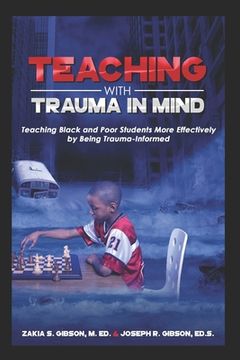Teaching With Trauma in Mind: Teaching Black and Poor Students More Effectively by Being Trauma-Informed: 1 (in English)
Synopsis "Teaching With Trauma in Mind: Teaching Black and Poor Students More Effectively by Being Trauma-Informed: 1 (in English)"
Please check out more of our related titles at thepgi.org!About five years ago, the National Task Force on Children Exposed to Violence recommended (or perhaps more accurately, warned) that "every school in our country should have trauma-informed staff and consultants providing school-based trauma-specific treatment." Apparently, few schools-especially those with high-poverty, high-minority student populations-actually heard (and heeded) the recommendation.Most teachers and administrators have accepted that there is simply not enough time to focus on "soft skills" like teaching impulse control, resilience, or emotional regulation and concurrently cover enough content to get test scores high enough to maintain their employment. Our rebuttal to this conclusion is that time isn't their problem, values and priorities are. In other words, if being a trauma-informed educator was adequately valued, then it would be prioritized and time would be "found" to be a trauma-informed educator.Becoming trauma-informed also requires a fundamental understanding that trauma, to quote Catherine Woodiwiss, "permanently changes us." Specifically, the chronic stress accompanying ongoing (or complex) childhood trauma can negatively and enduringly change a child's brain. Childhood traumas like physical or emotional abuse, sexual assault, and persistent family poverty typically triggers neuroplasticity.The commonness of students in classrooms across this country experiencing trauma and trauma-based maladaptive neuroplasticity is far greater than most of us would ever comfortably imagine. Most studies have concluded that 25-40% of all students have already been exposed to (and their brains changed by) some type of acute or complex childhood trauma. Considering the traumatic impact of race and poverty, instead of 25-40%, in these schools we're possibly looking at closer to 80-90% of students presumably having already been exposed to (and their brains negatively changed by) childhood trauma.Race and poverty are highly prevalent traumatic stressors-logically-in schools that have higher percentages of Black and poor students. However, because race and poverty are not typically recognized by educators as traumatic stressors, trauma is not looked at as the most likely motivation for the common negative student behaviors experienced in such schools. Moreover, becoming more trauma-informed is not particularly valued by educators in schools that have higher percentages of Black and poor students as a means of becoming more effective in managing these negative student behaviors.Students impacted by childhood trauma tend to struggle with regulating negative emotions and impulsivity as well as overcoming their overreliance on self-handicapping academic behaviors. They tend to disproportionately engage in disruptive classroom antics, apathy, absenteeism, noncompliance, incompetence, excuses, vulgarity, and misplaced aggression. Oftentimes, school gradually stops being understood as a priority for students experiencing childhood trauma; survival, or rather, somehow dealing the fear of not surviving, semiconsciously becomes too much of a priority.Unfortunately, childhood trauma isn't typically perceived or responded to the same in high-poverty, high-minority schools as it is in more affluent, majority-White schools. There's a greater reluctance to be trauma-informed among the instructional staff serving the former because the negative classroom behaviors of poor, Black or Latino students are automatically seen as confirmation of stigma-based expectations rather than consequences of trauma-based maladaptive neuroplasticity. Fortunately, this reaction can be acknowledged and successfully modified.

